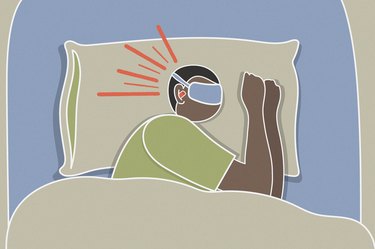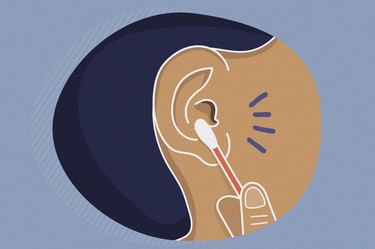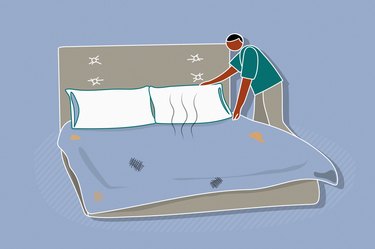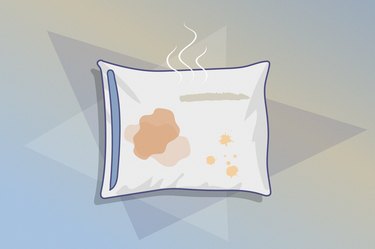
Whether it's traffic rushing past your bedroom window, a screaming baby in the apartment next door or your partner snoring like a chainsaw, earplugs can be a godsend for sleep.
Indeed, environmental noise is a major cause of sleep disturbances, according to a December 2014 study in Sleep Science. Poor sleep is associated with a greater risk of obesity and diabetes, high blood pressure, compromised immunity and cardiovascular disease. It's also linked to anxiety, depression and substance abuse.
Video of the Day
Video of the Day
The study also found that nighttime noise is linked to daytime sleepiness, decreased wellbeing, impaired cognitive performance and irritability. Exposure to the sound of traffic at night puts you at higher risk of hypertension, heart disease and stroke. The study concludes by recommending "avoidance at all costs of sleep disruptions caused by environmental noise."
Enter, earplugs: A September 2017 study in the Journal of Sleep Research found that earplugs had positive effects on sleep quality for patients in the ICU. Hear, hear!
But while they may help you drift off to dreamland, could they be bad for your ears? We consulted experts.
4 Earplug Mistakes That Could Harm Your Ears
Wearing earplugs isn't necessarily bad for your ears, even if you wear them every night. But if you have ear pain after using earplugs, you're probably making one of these mistakes that can jeopardize your ear health:
1. Inserting Them Too Deeply
Ouchy ears could be a sign that your earplugs are rubbing against the bony part of your ear canal.
"When something touches the deeper part of the ear canal, it is quite painful," says neurotologist Elina Kari, MD, assistant professor of surgery at UC San Diego Health. "Earplugs are only meant to fit in the first third of the canal."
To make sure you're not going too far: "You should always be able to grab your earplug with two fingers," Dr. Kari tells LIVESTRONG.com.
2. Choosing Wax or Silicone Earplugs
You might be better off steering clear of these moldable, putty-like earplugs.
"If you put too much in your ear canal, it can be quite painful to remove," Dr. Kari says. "In addition, they might break off and get stuck inside."
3. Using Them With Impacted Earwax
Your ear canal is designed to naturally push out earwax. But if an earplug is blocking the way, it can't eject the wax. "In fact, earplugs can push wax in further, possibly leading to impaction," Dr. Kari says.
What's more, according to January 2017 clinical practice guidelines from the American Academy of Otolaryngology-Head and Neck Surgery, earplugs can actually stimulate the cerumen glands (which make earwax), leading to excessive wax production — a process researchers have dubbed "mechanical milking."
If you have an earache, reduced hearing, a sensation of fullness in your ears, tinnitus (ringing in your ears) or vertigo (dizziness), talk to your doctor.
4. Yanking Them Out Too Quickly
"If your earplugs have a nice, tight seal around the opening of your ears and you rip them out really quickly without first breaking the seal, it can lead to micro-hemorrhages in the blood vessels of the eardrum," Dr. Kari says. "This will cause a very small hematoma, or bruise, which is quite painful, and you may lose your hearing temporarily."
Typically, you don't need do anything about the hematoma; over time it will heal on its own. "Although it's pretty rare, in very severe cases you can potentially perforate your eardrum," Dr. Kari says.
When removing earplugs, grab one edge of it with your finger and slowly lift up. "You can hear the air get in, and once you feel that pressure release, slide the earplug out," Dr. Kari says.
4 Times You Shouldn’t Wear Earplugs
Hear this: They could worsen certain conditions. Steer clear if:
1. You Have Pus in Your Ear
"Milky yellow or green drainage is a sign of infection, and you should have it checked out," Dr. Kari says. "Earplugs can exacerbate an ear infection."
2. Your Ear Itches
Inflammation is often to blame for itchy ears.
"Earplugs could worsen itching in some people, and trigger infection in those with chronic inflammation," Dr. Kari says.
3. You Have Tinnitus
Regular earplugs won't work for you because when you block out background noise, the ringing in your ears is amplified.
"All you can hear is your own tinnitus," says Dr. Kari. "Instead, try wearing electronic earplugs that emit their own sound, such as white noise."
4. You Had an Ear Operation
Check with your ear surgeon before popping in plugs, Dr. Kari says.
How to Find the Best Earplugs for Sleeping
1. Opt for Foam
There are tons of options for earplugs out there, but one style stands out above the rest for most people: "You want something soft and flexible — the best ones are the little foam earplugs," Dr. Kari says, who opts for this type of earplug herself. "You pinch them between your fingers to shrink them, insert them in your ear canal and they slowly expand back so that they fit to your size."
If you find that your earplugs slip out, try a different size. Some are specifically made to fit slim or wide ear canals. "You can also get custom earplugs from an audiologist," Dr. Kari says.
2. Look for the NRR
Another thing to look for when shopping for earplugs is the Noise Reduction Rating (NRR), which should be listed on the packaging. The higher the NRR, the more ambient noise the plugs will block. "Most earplugs provide a max of 33 decibels of sound reduction," Dr. Kari says.
That means they will completely block out a soft whisper, which is about 30 decibels, according to the Centers for Disease Control and Prevention (CDC). Meanwhile, the roar of a 95-decibel motorcycle will be muffled, but not totally silenced.
Try One of These Options
- Howard Leight MAX-1 Foam Earplugs (Buy it: Amazon.com; Price: $6.95 for 20)
- Flents Quiet! Please Foam Earplugs (Buy it: Walgreens.com; Price: $2.99 for 6)
How to Properly Insert Foam Earplugs
Using the right technique will make your plugs more effective. Here's how to do it, per the CDC.
- Roll the earplug into a thin cylinder between your fingertips.
- With your opposite hand, pull up on the top of your ear so that you have a straight shot into the ear canal. Carefully guide the earplug inside.
- Gently press a finger against the earplug for several seconds as it expands to fill your ear canal.
- Place your hands firmly over your ears. If background sounds are significantly more muffled, then the earplug hasn't created a tight seal. Remove it and give it another shot.
While we're at it, a quick hygiene reminder: "Your hands should be washed and dried before inserting earplugs to prevent the risk of infection," says Robert del Junco, MD, an otolaryngologist with Providence St. Joseph Hospital in Orange County, CA. "It is also important to clean your earplugs daily to prevent possible infections." (Wash them with mild soap and warm water, then allow them to air dry.)
Dr. Kari says you can reuse the foam earplugs several times before replacing them. She switches hers out once they start getting discolored.
Not a Fan of Earplugs? Try One of These Strategies Instead
Rest assured, you're on your way to a peaceful night's sleep with one of these earplug alternatives.
1. Play White Noise
The theory behind white noise is that by concealing background sound, it can help your brain relax so you can drift off more easily and spend longer in dreamland.
A small June 2016 study in the Journal of Caring Sciences found that exposure to white noise improved sleep duration and quality in patients in a coronary care unit; while a small August 2012 study in the Journal of Theoretical Biology suggested that older adults who listened to "pink noise" (which has a lower register than white noise) experienced significantly better sleep quality.
But the most recent research urges caution. A February 2021 review in Sleep Medicine Reviews concluded that the quality of evidence for continuous white noise improving shut-eye is low, and warned that it might negatively affect sleep and hearing.
Still, Dr. Kari says it's typically a safe alternative that can effectively distract you from sounds that might interrupt your sleep. "It should be in the 50-decibel range and not exceed 80 decibels," she says.
For reference, 50 decibels is about as loud as an air conditioner or refrigerator hum, while 80 decibels is akin to hearing a lawnmower or leaf blower, per the CDC. Check the noise machine specifications to see where it falls.
"In addition, you should be distanced from the machine," Dr. Kari says. Don't place it on your nightstand right next to your head. (The same advice holds if you're using a white noise app on your phone.)
Or use a fan. "A fan will also produce white noise to help mask the ambient sounds that may wake you up at night," Dr. del Junco says.
2. Remove Disruptions
When possible, eliminate the source of noise. Repair or replace noisy appliances, and if your partner snores, ask them to wear nasal strips or a mouthguard (or have them try other snoring remedies).
"Turn off your cell phone so that any emails or texts you receive during the night will not disturb your sleep," Dr. del Junco says. Another option is to turn on the "do not disturb" mode. "And if you have pets that sleep in your bed at night, think about putting them out."
A small September 2017 study in Mayo Clinic Proceedings found that sharing a bed with your dog reduced sleep quality.
Falling asleep with the TV on (which 61 percent of Americans do, according to a July 2014 Ebiquity survey) is a hard no.
3. Choose Curtains and Carpets
According to the Sleep Foundation, plush carpeting and drapes absorb sounds better than wood floors and blinds.
If noises from outside are keeping you up, consider springing for soundproof curtains and making sure your windows are properly sealed.
4. Slide on a Bluetooth Eye Mask
Meet one of the latest and greatest sleep products to hit the market: Bluetooth eye masks are cleverly designed to block light while streaming soothing music, nature sounds or white noise through built-in speakers on the sides.
Try One of These Options
- TOPOINT Bluetooth Sleep Eye Mask (Buy it: Amazon.com; Price: $22.59)
- Lightimetunnel Bluetooth Wireless 3D Eye Mask (Buy it: Amazon.com; Price: $22.59)
So, How Bad Is It Really to Wear Earplugs Every Night?
Expert consensus: For the vast majority of people, it is totally safe — and can significantly improve your sleep. Plug away!
- National Institute on Deafness and Hearing Disorders: "How Do We Hear?"
- American Academy of Otolaryngology-Head and Neck Surgery: "Clinical Practice Guideline (Update): Earwax (Cerumen Impaction)"
- Sleep Foundation: "Best Earplugs for Sleep"
- CDC: "How To Wear Soft Foam Earplugs"
- CDC: "What Noises Cause Hearing Loss?"
- Mayo Clinic Proceedings: "The Effect of Dogs on Human Sleep in the Home Sleep Environment"
- Journal of Caring Sciences: "Effect of White Noise on Sleep in Patients Admitted to a Coronary Care"
- Journal of Theoretical Biology: "Pink noise: Effect on complexity synchronization of brain activity and sleep consolidation"
- Pediatrics: "Infant Sleep Machines and Hazardous Sound Pressure Levels"
- Sleep Science: "Environmental noise and sleep disturbances: A threat to health?"
- National Sleep Foundation: "There’s No Place Like Home for Sleep According to New National Sleep Foundation Bedroom Poll"
- Ebiquity: "Man's New Best Friend: TV Is A Constant Companion For U.S. Consumers"
- Journal of Sleep Research: "Effect of the use of earplugs and eye mask on the quality of sleep in intensive care patients: a systematic review"
- leep Medicine Reviews: "Noise as a sleep aid: A systematic review"
Is this an emergency? If you are experiencing serious medical symptoms, please see the National Library of Medicine’s list of signs you need emergency medical attention or call 911.



